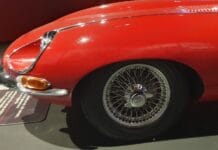If you love looking through classifieds of classic cars, you’ve noticed that some of them have fender-mounted side mirrors. The conventional door-mounted mirrors are easy to adjust and clean so why would manufacturers mount the side mirrors on the fenders?

Classic Datsuns, the legendary Toyota 2000GT, Mercedes-Benz 300 SL, many cute old British sports cars have fender-mounted side mirrors. A lot of vintage Japanese cars had this peculiar design feature. However, new cars are never like that.
The mirrors of the Mercedes-Benz 300 SL are mounted on the fenders because its gullwing doors open upwards and need to be as light as possible. Meanwhile, the law in Japan up until 1983 said that the side mirrors must be observable through the windshield and not the side windows. Weird, isn’t it?

It has to be said, fender-mounted side mirrors have their advantages. First of all, thanks to them, the car cam be narrower, even if just by a little bit. This really helped in tight streets of the Japanese cities. Secondly, there is hardly any blind spot. Finally, fender-mounted side mirrors are always in the driver’s field of vision. You don’t even have to turn your head to look at them, because they are always right in front of you, behind the wiper-cleaned glass.
But the fender-mounted mirrors have disadvantages too. They are more difficult to adjust on the go. They are also very far away, making it more difficult to assess the situation when driving in reverse. Fender-mounted mirrors are also not helping the pedestrian safety. In fact, thanks to the new safety regulations, fender-mounted mirrors are pretty much illegal.

The law obliging Japanese automakers to install mirrors in front of the windshield was repealed in 1983 and now pretty much all new cars have door-mounted side mirrors. Door-mounted mirrors are just more practical. But in the future side mirrors will probably disappear completely and will be replaced by cameras. So who cares.




